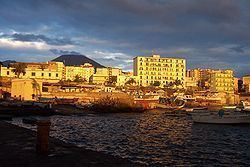Demonym(s) Torresi or Corallini Postal code 80059, 80040 Local time Monday 2:04 PM | Time zone CET (UTC+1) Dialing code 081 Patron saint Januarius | |
 | ||
Weather 16°C, Wind NE at 23 km/h, 59% Humidity Points of interest Valle dell'Orso, Valle dell'Avventura, Villa delle Ginestre, Palazzo Vallelonga, Museo del Corallo | ||
Torre del Greco ([ˈtorre del ˈɡrɛːko]; ("Greek man's Tower") Neapolitan: Torre d' 'o Grieco) is comune in the Metropolitan City of Naples in Italy, with a population of some 88,000 as of 2007. People are sometimes called Corallini because of the once plentiful coral in the nearby sea, and because the city has been a major producer of coral jewellery and cameo brooches since the seventeenth century.
Contents
- Map of 80059 Torre del Greco Naples Italy
- Ancient and early medieval period
- Middle ages
- 19th and early 20th century
- Climate
- Economy
- Main sights
- Cameos and coral jewellery
- Twin towns
- References
Map of 80059 Torre del Greco Naples, Italy
Ancient and early medieval period
Historically part of Magna Graecia, the area was first colonised by ancient Greek settlers. In Roman times, Torre del Greco was probably a suburb of Herculaneum, characterized by patricians villas. After the 79 AD eruption of Vesuvius which destroyed the area, two villages are known to have existed in the area, Sora and Calastro. The Byzantine general Belisarius moved their inhabitants to Naples in 535. Around 700, it was also known as Turris Octava, the Latin for The Tower of Eight [sides] or The Eighth Tower, probably referring to a coastal watch tower. The current name appears for the first time in 1015; according to tradition, it stems from a Greek hermit who took up residence in the tower, or from the cultivation of a particular vine from Greece.
Middle ages
Torre del Greco was part of the royal estates of the Kingdom of Naples, until King Alfonso V of Aragon ceded it to the Carafa family.
In 1631 Torre del Greco was again damaged by an eruption of Vesuvius. Its citizens bought back their rights in 1699, after paying 106,000 ducats to their landlord, the Marquis of Monforte, and thenceforth the city flourished as a maritime trading and fishing port. The tradition of coral crafting dates from this time.
The historical centre of Torre del Greco was buried under a 10-metre-deep (33-foot) layer of lava in 1794.
19th and early 20th century
At the time of the French rule of Joachim Murat, Torre del Greco, with 18,000 inhabitants, was the third largest mainland city in the Kingdom of Naples after Naples and Foggia.
Starting in the 16th century, wealthy families and even Italian nobility built elaborate summer palaces on the outskirts of the town. Among the most notable of these is the Palazzo Materazzo, renovated in the 1970s as a dance school, but later taken over by squatters after a 1980 earthquake destroyed the homes of many of the poorer residents. In the 19th century, and continuing into the early 20th century, Torre del Greco was a popular summer resort for wealthy Italians.
In its heyday Torre del Greco was renowned for its cafés and eateries, particularly the "Gran Caffè Palumbo", a large Art Nouveau café with an extensive outdoor pavilion known for its gelato, pastries, food and coffee. The famous Italian comedian Toto was among those who made Torre del Greco their annual summer retreat. The reason for Torre del Greco's popularity as a resort town was its fine beaches and the rural setting of lush farmlands and vineyards, as well as its close proximity to Vesuvius. As the town nearest to the volcano, Torre del Greco was the main starting point for tourists wishing to scale the mountain. This was facilitated by a funicular railway (the Vesuvius Funicular) which took tourists to the crater from the town.
During World War II, the city was used as an ammunition depot by the German army, and consequently suffered heavy bombing by Allied forces.
Climate
Torre del Greco experiences a Mediterranean climate (Köppen climate classification Csa).
Economy
The city is the headquarters of Banca di Credito Popolare di Torre del Greco.
Main sights
Cameos and coral jewellery
Diving for coral has taken place in the Mediterranean Sea ever since Roman times, and in the 15th century Torre del Greco became known for its coral diving and harvesting of red coral. However, it was not until the 17th century that the first cameos were produced, and not until 1815 that a unique manufacturing contract was granted to the town by the King of Naples for a period of ten years.
At present there are several hundred companies and several thousands of people employed in the manufacture of coral and shell cameos. Coral is now mainly imported from Asia, since areas in the Mediterranean are increasingly becoming protected. The total industry is estimated to have a turnover of around US$225 million.
Twin towns
Torre del Greco is twinned with:
